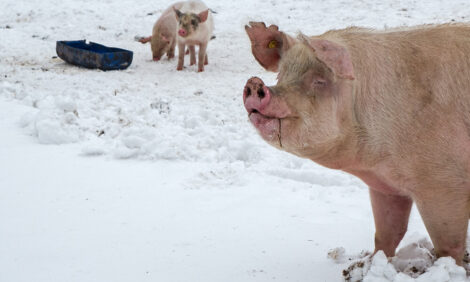



Canada Reduces Breeding Herd Numbers
US Weekly Hog Outlook, 3rd November 2006 - Weekly review of the US hog industry, written by Glenn Grimes and Ron Plain. Ron Plain
|
Canada is doing what the U.S. probably needs to do and that is reduce the size of the breeding herd. On October 1, Canada's breeding herd was 1.7% smaller than 12 months earlier. Canada's market herd was down 5.7% from the same date in 2005. The bigger reduction in the market herd and breeding herd is due, in part, to Canada sending more feeder pigs to the U.S.
Canada's third quarter pig crop was 3.4% smaller than the same period in 2005. Canadian producers plan to farrow 3% less sows in October-December than 12 months earlier.
The futures price for corn for the next year in late week was about $3.55 per bushel. With a high probability for corn prices to be $3.00 or more per bushel for the foreseeable future producers will need to reduce the size of the hog herd or we will need demand growth to keep hog producers profitable.
In the last five years the cost of producing hogs in Iowa by the average-cost-producer has been slightly less than $40 per cwt. In the next five years, their costs are likely to exceed $45 per cwt.
During these five years average U.S. hog prices for 51-52% lean hogs has been about $44.50 per cwt. Unless the hog herd is reduced in size or we get demand growth the average-cost-producer is likely to lose money in the next five years.
Live hog demand was down 0.8% in 2005 from 2004 and for the first 9 months of 2006 demand for live hogs has lost another 0.8% from 2005. With the strong competition expected from other meats it will require very strong exports to get live hog demand growth. Export growth is expected, but not at the rate of the last three years. With a relative high probability of little or no demand growth for live hogs likely compared to the last three years and some possibility of additional loss from the high level of 2004. Reducing the size of the hog herd is the most likely action that producers can take to maintain profitability in the hog industry.
Consumer demand was down for the three major categories of meat for January-September of 2006 compared to a year earlier. Based on preliminary data demand for pork was down 5.3%, beef was down 5.0% and young chicken demand was down 7.3% for the first 9 months of 2006 compared to the same months of 2005. The average weights for barrows and gilts last week in Iowa-Minnesota were up 0.6 pound from a week earlier and only 0.1 pound below a year earlier. The big decline in weight from a year earlier, week before last, was probably at least partially due to sample fluctuation.
Hog prices are continuing to hold well with the record high slaughter. Top cash prices Friday morning were up $2.25 to $4.00 per cwt compared to a week earlier. The weighted average negotiated carcass prices Friday morning were up $1.20 to $1.35 per cwt compared to 7 days earlier.
The top live Friday morning prices for select markets were: Peoria $45.00 per cwt, St. Paul $46.00 per cwt, Sioux Falls N/A and interior Missouri $45.00 per cwt. The weighted average negotiated carcass price Friday morning by geographic area were: western Cornbelt $46.16 per cwt, eastern Cornbelt $62.77 per cwt, Iowa-Minnesota $63.51 per cwt and nation $62.99 per cwt.
Pork cutout Thursday afternoon at $67.49 per cwt was up $0.43 per cwt from a week earlier. Slaughter this week under Federal Inspection was estimated at 2181 thousand head, up 1.9% from a year earlier.
ThePigSite News Desk








